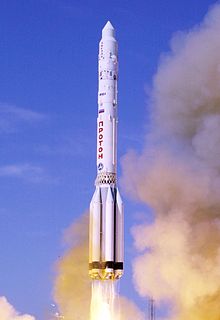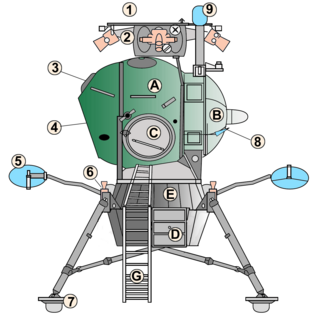Related Research Articles
Mars 2MV-4 No.1 also known as Sputnik 22 in the West, was a Soviet spacecraft, which was launched in 1962 as part of the Mars programme, and was intended to make a flyby of Mars, and transmit images of the planet back to Earth. Due to a problem with the rocket which launched it, it was destroyed in low Earth orbit. It was the first of two Mars 2MV-4 spacecraft to be launched, the other being the Mars 1 spacecraft which was launched eight days later.

Proton is an expendable launch system used for both commercial and Russian government space launches. The first Proton rocket was launched in 1965. Modern versions of the launch system are still in use as of 2020, making it one of the most successful heavy boosters in the history of spaceflight. All Protons are built at the Khrunichev State Research and Production Space Center factory in Moscow and Chemical Automatics Design Bureau in Voronezh, transported to the Baikonur Cosmodrome, brought to the launch pad horizontally, and raised into vertical position for launch.
The Voskhod rocket was a derivative of the Soviet R-7 ICBM designed for the human spaceflight programme but later used for launching Zenit reconnaissance satellites. It consisted of the Molniya 8K78M third stage minus the Blok L. In 1966, all R-7 variants were equipped with the uprated core stage and strap-ons of the Soyuz 11A511. The Blok I stage in the Voskhod booster used the RD-0107 engine rather than the crew rated and more powerful RD-0110 used on the Soyuz. The sole exception to this were the two manned Voskhod launches, which had RD-0108 engines, a crew-rated RD-0107 but with the same performance.

The Soyuz-U launch vehicle was an improved version of the original Soyuz rocket. Soyuz-U was part of the R-7 family of rockets based on the R-7 Semyorka missile. Members of this rocket family were designed by the TsSKB design bureau and constructed at the Progress factory in Samara, Russia. The first Soyuz-U flight took place on 18 May 1973, carrying as its payload Kosmos 559, a Zenit military surveillance satellite. The final flight of a Soyuz-U rocket took place on 22 February 2017, carrying Progress MS-05 to the International Space Station.

The Molniya, GRAU Index 8K78, was a modification of the well-known R-7 Semyorka rocket and had four stages.
Venera 2MV-2 No.1, also known as Sputnik 21 in the West, was a Soviet spacecraft, which was launched in 1962 as part of the Venera programme, and was intended to make a flyby of Venus. Due to a problem with the rocket which launched it, it failed to leave low Earth orbit, and reentered the atmosphere a few days later. It was the second Venera 2MV-2 spacecraft, both of which failed to leave Earth orbit.

Blok D is an upper stage used on Soviet and later Russian expendable launch systems, including the N1, Proton-K and Zenit.

The RD-58 is a rocket engine, developed in the 1960s by OKB-1, now RKK Energia. The project was managed by Mikhail Melnikov, and it was based on the previous S1.5400 which was the first staged combustion engine in the world. The engine was initially created to power the Block D stage of the Soviet Union's abortive N-1 rocket. Derivatives of this stage are now used as upper stages on some Proton and Zenit rockets. An alternative version of the RD-58 chamber, featuring a shorter nozzle, was used as the N-1's roll-control engine.

The LK was a lunar module developed in the 1960s as a part of several Soviet crewed lunar programs. Its role was analogous to the American Apollo Lunar Module (LM). Several LK modules were flown without crew in Earth orbit, but no LK ever reached the Moon. The development of the N1 launch vehicle required for the lunar flight suffered setbacks, and the first Moon landings were achieved by US astronauts. As a result, both the N1 and the LK programs were cancelled without any further development.

The Proton-M, (Протон-М) GRAU index 8K82M or 8K82KM, is an expendable Russian heavy-lift launch vehicle derived from the Soviet-developed Proton. It is built by Khrunichev, and launched from sites 81 and 200 at the Baikonur Cosmodrome in Kazakhstan. Commercial launches are marketed by International Launch Services (ILS), and generally use Site 200/39. The first Proton-M launch occurred on 7 April 2001.
The Molniya-M, designation 8K78M, was a Soviet carrier rocket derived from the R-7 Semyorka ICBM.

The Luna 8K72 vehicles were carrier rockets used by the Soviet Union for nine space probe launch attempts in the Luna programme between 23 September 1958 and 16 April 1960. Like many other Soviet launchers of that era the Luna 8K72 vehicles were derived from the R-7 Semyorka design, part of the R-7, which was also the basis for the Vostok and modern Soyuz rocket.

The Proton-K, also designated Proton 8K82K after its GRAU index, 8K82K, was a Russian, previously Soviet, carrier rocket derived from the earlier Proton. It was built by Khrunichev, and launched from sites 81 and 200 at the Baikonur Cosmodrome in Kazakhstan.

The Soyuz was a Soviet expendable carrier rocket designed in the 1960s by OKB-1 and manufactured by State Aviation Plant No. 1 in Kuybyshev, Soviet Union. It was commissioned to launch Soyuz spacecraft as part of the Soviet human spaceflight program, first with 8 uncrewed test flights, followed by the first 19 crewed launches. The original Soyuz also propelled four test flights of the improved Soyuz 7K-T capsule between 1972 and 1974. In total it flew 30 successful missions over 10 years and suffered two failures.

Mars 1M No.1, designated Mars 1960A by NASA analysts and dubbed Marsnik 1 by the Western media, was the first spacecraft launched as part of the Soviet Union's Mars programme. A Mars 1M spacecraft, it was intended for conducting flight testing system and to study the interplanetary environment between Earth and Mars, however it was lost in a launch failure before it could begin its mission.
The Blok DM-03, GRAU index 11S861-03, is a Russian upper stage used as an optional fourth stage on the Proton-M carrier rocket. Three have been launched, the first in December 2010; the first two launches failed before fourth stage ignition, the first as a result of a problem with the Blok DM's fuel load.

Progress MS-04, identified by NASA as Progress 65P, was a Progress cargo spacecraft launched by Roscosmos in an unsuccessful attempt to resupply the International Space Station (ISS).
Irtysh, also named Soyuz-5, formerly codenamed Fenix in Russian and Sunkar in Kazakh, is a planned Russian rocket that is being developed by JSC SRC Progress within the "Project Feniks". Initially it will replace the capability of Zenit-2 and Proton Medium, and in the future will serve as the base of a super heavy-lift launch vehicle rocket (Yenisei) to match the Energia/Buran capabilities. As of March 2019 It is expected to launch from the Baikonur Baiterek, the ex Zenit-2 launch site, in a partnership with the government of Kazakhstan, with a planned debut of 2022.

Soyuz 7K-L1E was a Soviet uncrewed modified Soyuz 7K-L1 spacecraft. Also called a dummy Soyuz 7K-LOK. Two were built, one Soyuz 7K-L1E was successfully launched into Low Earth Orbit on Proton rocket and is known as Kosmos 382. The other Soyuz 7K-L1E was placed on a N1 rocket, which failed at launch. The Soyuz spacecraft was first used in 1967 as the main crewed spacecraft and is still in use. Many Soyuz variations have been built and the Soyuz 7K-L1E was an unmanned variation.
References
- ↑ "US-K (73D6)". Gunther's Space Page. 2012-03-08. Retrieved 2012-04-21.
| | This rocketry article is a stub. You can help Wikipedia by expanding it. |